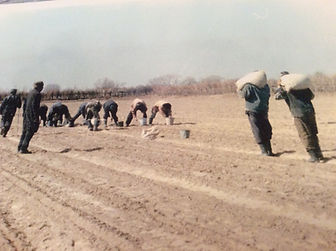The Aral Sea Crisis
The Aral Sea was once the world's fourth largest lake.
Now, it's almost gone.
Scattered by the wind, toxic pollutants from the lakebed are poisoning neighboring communities.
Featured Video
THIS CATASTROPHE CANNOT BE OVERLOOKED!
The consequences are not limited to the people of the Aral region:
-
Increased salt deposits from the Aral have been measured across the world.
-
The water bodies of the Aral Region supply water to 5 different countries
-
Uzbekistan is becoming an increasingly significant player in global economics.
In the summer of 2016, our founding member took a trip to the dying Aral Sea. She visited Muynak, an old port city on the dried up shoreline. What she saw stunned her.
A row of rusted, beached ships lay below in the desert that was left behind. The inhabitants, ex-fishermen, said that the sea had receded by more than 62 miles and that there would be nothing left at all within two years. Instead of water, there was a vast, new desert. The locals call it Aralkum (Aral-Sand).





All this is a result of the agricultural politics of the Soviet Union, which had the goal of maximizing cotton output from the region around the Aral’s tributary rivers, the Amudarya and the Sindarya. Increased water tapping from these rivers resulted in a dried out lake.



In the 1950’s, the Aral Sea was the fourth largest land-bound body of water in the world and occupying a territory greater than Switzerland. It was around 26,250 miles squared: 265 miles long, 176 miles wide and 223 feet deep. In 1961, the area of the sea began to exponentially decrease, resulting in today's 20,850 miles squared of dried seabed left behind.

Image Credit to: http://www.investigacionyciencia.es/files/25758.jpg
All this land is covered in salt. In some places there is even a layer of pesticides and other poisonous chemicals, previously deposited into the sea from nearby fields. Dust storms transport the salt, dust and poisonous chemicals up to a distance of 300 miles. Bicarbonate nitrate, chloride nitrate and sulfate nitrate are transported by the winds and disrupt or destroy the development of agricultural projects throughout the region.
The local population suffers from respiratory illnesses, anemia, and larynx and esophagus cancer. There are also increasingly frequent cases of liver, lymph and eye diseases. Muynak's local children's hospital is filled with premature cases of such illnesses, with little resources to combat them.
According to experts, the pollution is additionally dangerous due to the fact that the Aral Sea is located on the path of a strong West-to-East air current, which can transport aerosols from the ground into the upper levels of the atmosphere. As a result, traces of increased salt deposition have been recorded in distant countries. This is a catastrophe on a global level.






At this point, there is little one can do to save the sea. However, local populations across the entire Aral Basin still suffer and are in desperate need of aid. Various solutions have been developed to address the crisis. On the Aral, walls of saxaul trees can be planted to prevent toxic sands from blowing into bordering towns. Fruit trees adaptable to saline soil can help prevent malnutrition. More efficient water management will increase the amount of uncontaminated water entering the lower Aral Basin.
This catastrophe is too much for a single country to handle and much more needs to be done. We have thus chosen to lead an initiative to shine light on this catastrophe and encourage Americans to do what they can to relieve the afflicted populations.
With this background, we decided to establish a non-profit charity for the Aral region. The goal of our project is to represent a new outlet for aid in a region often overlooked by the global community. With small steps, we intend to help stabilize the climate and provide a new outlet for survival through partnerships with local towns and programs. Our current work centers on a partnership with towns in Khorezm region. Cooperating with local initiatives, we work to help relieve the medical and economic disaster inhabitants now face.
To do so, however, we need the help of a committed team of volunteers and donors willing to support the operations of our organization. This catastrophe may truly be the worst manmade environmental disaster of history and can no longer be overlooked.

